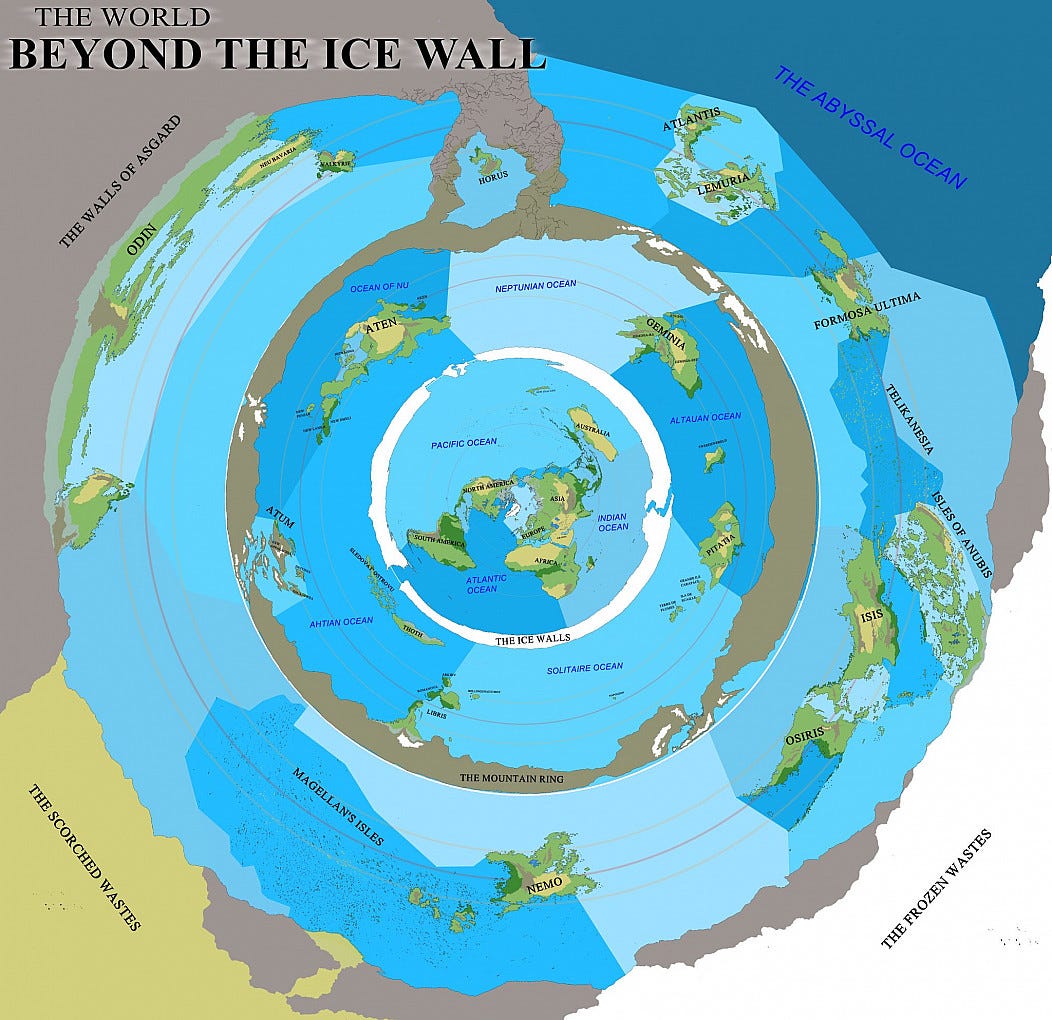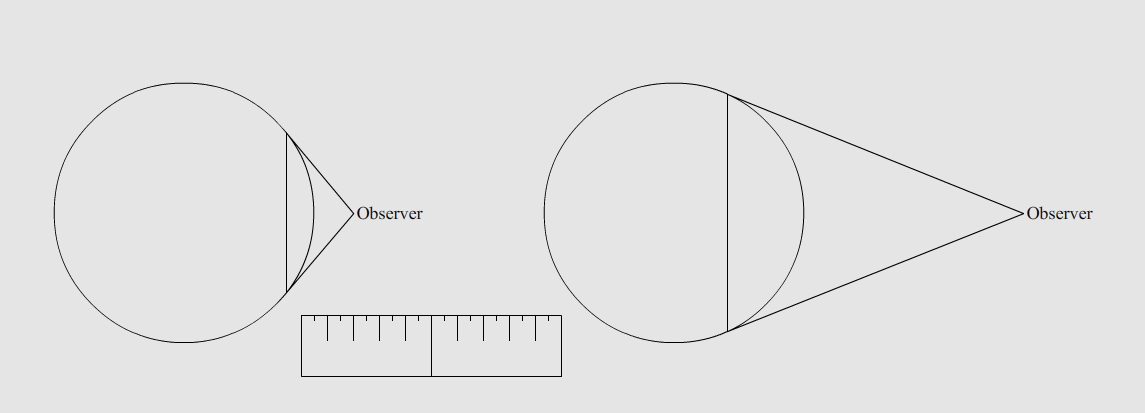Epistemology and Dialectics: the Shape of the Earth
How to put this argument to bed once and for all
Spend any time watching blue-pilled midwits on ScrewTube, and you will eventually come across a pseudoscience tier list. Sometimes they are organised by level of apparent danger in believing them, and “climate change denial” is at the top of the list, but usually, they are organised by level of silliness, with young-Earth being A-tier, and flat-Earth being S-tier. The reason for this is because a lot of these blue-pilled midwits portray pseudoscience as a slippery slope, with questioning whatever narrative they wish to defend as the first step to believing utter nonsense. “Listen and believe, don’t question what the experts™ say about the current thing, because then you’ll go down a rabbit hole to believing the Earth is flat,” as the over-arching narrative goes. I am here to tell you to question everything, and the key to determining truth from falsehood is to have an active mind, not to be a compulsive contrarian and reflexively believe the exact opposite of everything the Cathedral tells you; that is how you go from being a garden-variety dissident to believing utter nonsense. For that reason, I’m starting from the pinnacle of silliness and moving in the direction of more plausible narratives, beginning with the shape of the Earth, and then in future instalments, moving on to other ideas, such as the age of the Universe and whether or not vaccines are actually beneficial. Word of warning, however, I will be covering historical narratives in this series, not just scientific topics.
The best way to evaluate scientific-sounding narratives is to treat them as conspiracy theories, especially because there is usually a conspiratorial element to them anyway. “They” (or (((they))) as it may be) don’t want you to know this, so “they” invented an entire field to cover it up! But is this really the case? Part of the reason that the Cathedral has as much credibility as it does is that not every narrative it propagates is false. Just as a broken clock is right twice a day, sometimes the mainstream narrative is actually right. If a particular narrative is inconsequential to the Cathedral’s power, then the Cathedral has no reason to lie about it, rather, Cathedralites have every reason to tell the truth about it specifically to establish credibility with the outside world, and lie about only that which gains them prestige within the Cathedral itself. As a reminder, when evaluating any narrative, the first question to ask is “cui bono.” Who benefits from this narrative being false and propagating it anyway? If the answer is “no-one,” then the debate can end there, the narrative is probably true.
Now, flat-Earthers, or “flerfers,” as I will call them henceforth, will tell you that the shape of the Earth is of consequence, that the Cathedral does have a reason to lie about it, because there is something beyond the Antarctic Ice Wall that “they” don’t want you to know about, and that’s why you can’t visit Antarctica. You can probably end the argument right here, because that’s not true, you can visit Antarctica, it’s just not particularly easy. Because there isn’t a lot of demand to do so, there are very few options for travelling there, and the ferries are rather picky about whom they let on, but there is no prohibition on travelling to Antarctica, and even if there were, the Antarctic coast is hardly lined with armed guards and checkpoints to make sure that no-one can travel too far and potentially see the edge of the Earth. There have been fairly well-documented journeys to the South Pole in the past, in fact I’ve been on one, albeit in a past life.
Kidding, kidding (mostly), but even if there weren’t any documented expeditions to the South Pole, there are other ways of proving that the Earth is not flat. That being said, flerfers are surprisingly good at debates, hence the “dialectics” part of the title. Aside from the rare theological argument as to why Christians must believe the Earth is flat (shoutout to
for drawing my attention to that one), one that has even most biblical literalists blowing milk through their nostrils, flerfers tend to have an awful lot of obscure scientific knowledge that they think will dazzle their interlocutors with brilliance, whereas scientifically literate observers know that the poor normie is just being baffled with bullshit. I’ll explain a little later, because it’s best to tackle the simple arguments first.One of the simplest arguments against flat-Earth is that flerfers cannot agree on what the Earth actually looks like. The map with the North Pole as the centre of a disc with Antarctica as an ice wall keeping the oceans from draining off the edge is the most common, and it is the only one I know of that ties in with a world beyond…
…but it is hardly the only map out there. Flerfers can’t even agree on whether or not Australia is a real place, and this is where things get very funny. While it is common for Europeans to dunk on Americans for believing weird shit, most of the flerfers I’ve run into online have been British, and there is a running gag among Aussies who like to fuck with them that Australia is a made-up place, and Aussies are all just a bunch of actors living in Sheffield. Any Aussies reading this, let me know if you’ve participated in this farce. Anyway, when you point out to a flerfer that their movement doesn’t have a consistent model, they will counter that round-Earthers don’t either. Wait, what? Yes, really.
Note the inconsistency of the size of North America relative to the size of the Earth itself. Flerfers will use this to support their claim that these images, “allegedly photographs taken by astronauts,” are actually fabricated. Luckily, you don’t need to be an astronaut or even have worked for NASA to debunk this, you just need a cursory knowledge of photography, and in particular, perspective.
The closer an observer is to a sphere, the less of the surface can be captured in an image. In the illustration on the left, the observer’s distance from the surface is 15% the diameter of the sphere, and the amount of surface that can be seen is 62% the diameter of the sphere. In the illustration on the right, the observer’s distance from the surface is 85% the diameter of the sphere, and the amount of surface that can be seen is 90% the diameter of the sphere. I included a little scale so that you can verify these numbers for yourself. You can easily replicate the effect observed in the NASA photos by getting a desk globe and taking pictures of it at different distances, using a wide-angle lens such that the entire surface is in the shot and the outline is always a circle.
Now of course, just because there is no trickery with the photography still doesn’t mean these images are real. After all, how do we know that these photos are of an actual planet, and not a model? Well, that’s where we enter the realm of claims as unfalsifiable as my past-life friendship with Earnest Shackleton. I can make shit up too! Such is the double-edged nature of solipsism. However, we don’t really need to take pictures of the Earth to prove that it isn’t a disc. After all, globes have existed since long before space flight was technologically possible, and educated people have known since long before the time of Christopher Columbus that the Earth is round, since about 300 BC, in fact. The oldest and simplest way to demonstrate the Earth’s curvature is to simply head out to the ocean and observe ships. Notice that, rather than shrinking to an infinitesimal dot, a ship disappears over the horizon from the bottom up, such that the very last thing you see are its mastheads. In fact, in the old days of tall ships, lookouts could tell you what nation a ship in the distance was from before they could tell you what type of ship it was. Flerfers have a number of rebuttals to this, varying from “well, the Earth isn’t completely flat” to “the government has installed holographic technology to create this illusion.” In any case, what they lack is a model of their own to compete with the current globe, and so they cannot explain either how much curvature the discworld actually has or how the holographic technology works.
Moving on, a lot of flerfers believe in some other weird shit, and I have personally interacted with someone who also subscribes to the Electric Universe model. This is the point where we get into lesser-known aspects of cosmology that were hypothesised back in the early 19th century and, in some cases, still being debated today. While the idea of luminiferous aether no longer has any mainstream appeal, the idea of dark matter still persists, despite being on equally shaky ground. The flerfer that I encountered made the mistake of bringing up the lack of aether wind, probably not expecting that I would counter by citing the Michelson-Morley experiment of 1887. The even earlier Airy’s Failure is sometimes brought up in flerf debates, as is the Sagnac effect, which is a more recent discovery that has served to explain most of the phenomena previously attributed to luminiferous aether. None of these experiments relating to aether, the most recent of which took place in 1925, were about proving whether or not the Earth is stationary, rather, they were about proving whether or not aether itself existed as described.
The typical flerfer is used to debating someone just getting into the debate-bro sphere and mistakenly believes flat-Earth to make for easy target practice. They are not accustomed to debating someone with knowledge of advanced physics like yours truly, hence being able to get away with saying things like “round-Earthers deny basic physics” and then misrepresenting some exotic bit of trivia that most people wouldn’t be able to refute on the spot. I’ve said it before, and I’ll say it again: live debates are a source of entertainment, not truth. Engaging in live debates is a waste of time if you actually care about truth, which is why serious scholarly debates are conducted in the form of back-and-forth essays, allowing each party to take all the time they need to research claims and carefully construct counter-arguments. Flerfers like to boast that “scientists won’t debate me” as if that were a badge of honour, but just like several other ideas which will be explored in later instalments, that’s not because the scientists are afraid of being proven wrong, but because there’s nothing to debate; flerfers don’t actually have a competing idea. “Round-earthers” have a coherent thesis, whereas flerfers are endlessly chasing an unattainable antithesis because they cannot figure out how to explain observable reality fits their failed hypothesis. On the rare occasion that they actually conduct an experiment, that experiment either fails, or doesn’t produce a meaningful result. Other wacky ideas out there follow the same pattern, it’s when the pattern breaks down that a scientific-sounding idea deserves some serious consideration, though it will take some time going down the “pseudoscience tier list” before that happens. Some of you already know where this is going, but for the rest of you, nothing is off the table. I’ll even take requests! In fact, let’s turn it into a game: Stupid or PsyOp? I haven’t exactly been shy about admitting that I think flerf is a psyop…
How to Spot a Psychological Operation
Long-time readers of mine, as well as newcomers who fell in love my writing to the point of voraciously reading everything I’ve ever written (I see you, don’t worry, your secret is safe with me), are aware that I have a few articles containing the question “stupid or psyop” in the title. Let’s be honest, however: if a conspiracy theory smells like a ps…
…but not all pseudoscientific narratives out there are. Furthermore, the idea that flerf is a psyop is a hypothesis separate from the validity of flerf itself, so perhaps that will be a future instalment, especially if I can find the smoking gun that I keep hearing does in fact exist. Anyway, I have a splitting headache and no idea how to end this. Go away now.






Ernest Shackleton was my father's top hero in life, watched his eyes well up every time he told the story
Anyone in this day and age can hop on a plane and visit the opposite hemisphere to watch the stars rotate about the other celestial pole—in the opposite direction!